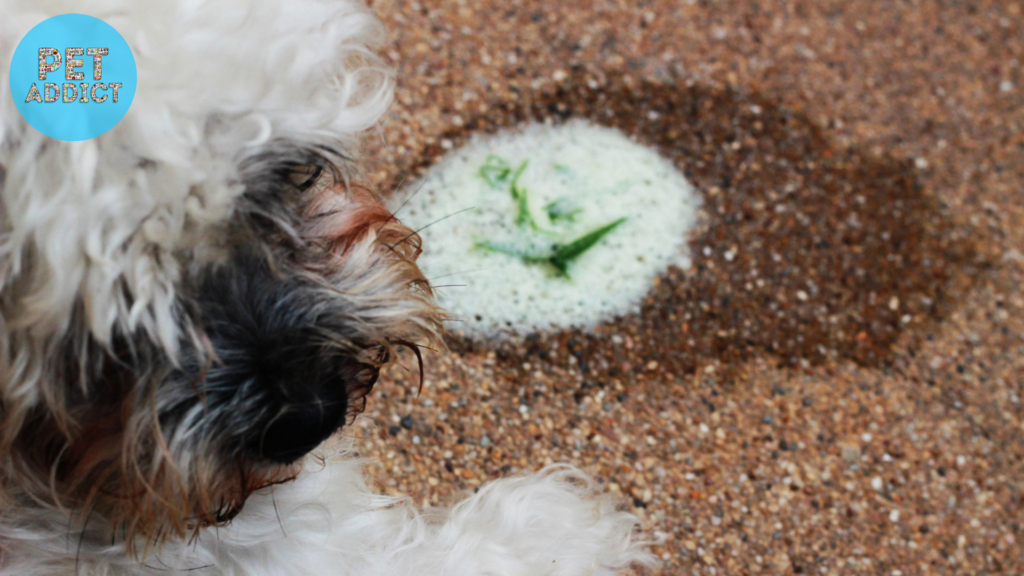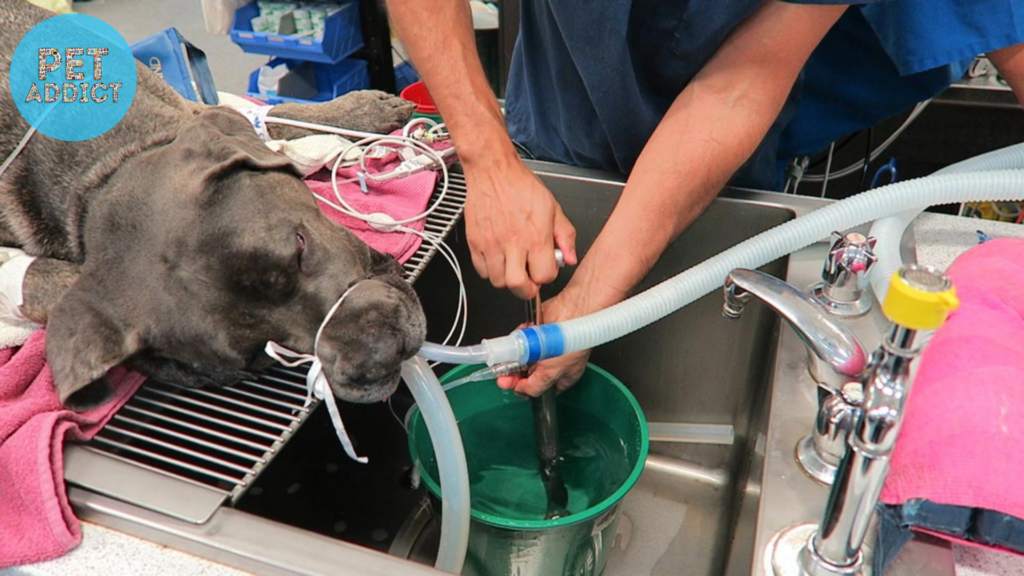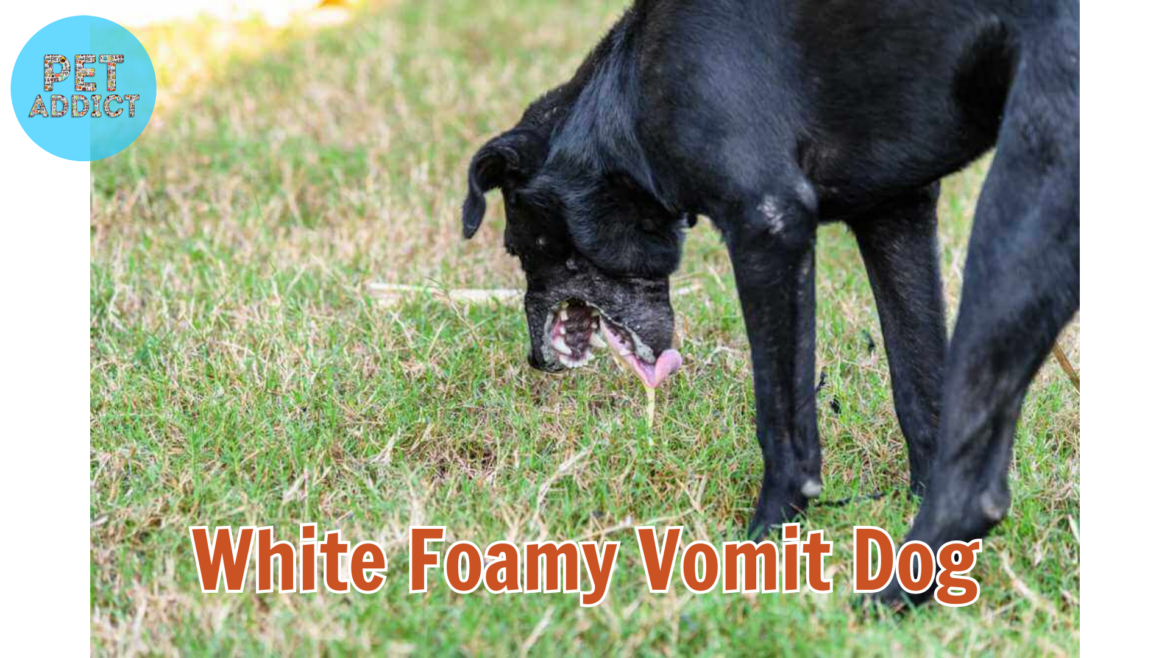As devoted pet owners, our dogs hold a special place in our hearts, and their well-being is of utmost importance to us. However, witnessing our furry companions experiencing health issues, including vomiting, can be distressing. While occasional vomiting is a normal bodily response in dogs, white foamy vomit can be a cause for concern. In this article, we will delve into the topic of white foamy vomit in dogs, understanding its potential causes, recognizing associated symptoms, and exploring the most effective ways to deal with this condition.
PetAddict.net – The best place where you can find everything about your pet!
Understanding White Foamy Vomit in Dogs
What is white foamy vomit? White foamy vomit in dogs refers to the expulsion of a frothy, bubbly substance from the stomach through the mouth. This particular type of vomit often has a white or light yellow color and may be indicative of various health issues.

Distinguishing between regurgitation and vomiting: It is important for pet owners to differentiate between regurgitation and vomiting. While vomiting involves forceful contractions of the stomach, regurgitation is a passive process where undigested food comes back up without the associated retching. Determining whether the dog is vomiting or regurgitating can aid in identifying the underlying cause.
Common causes of white foamy vomit in dogs: Several factors can contribute to white foamy vomit in dogs. These include dietary issues, gastrointestinal problems, toxic ingestion, gastric dilation-volvulus (bloat), pancreatitis, and infections or parasitic infestations. Each cause requires a specific approach to management and treatment.
Symptoms and Indications

Associated symptoms: In addition to white foamy vomit, dogs experiencing this condition may display other symptoms such as lethargy, loss of appetite, diarrhea, abdominal discomfort, and excessive drooling. Observing these associated symptoms can provide important clues to the underlying cause.
When to seek veterinary assistance: As responsible pet owners, it is essential to be aware of the red flags that indicate the need for immediate veterinary attention. Persistent vomiting, severe abdominal pain, lethargy, and signs of dehydration are some of the critical indications that require prompt medical care.
Potential Causes of White Foamy Vomit

Dietary causes: Abrupt changes in diet, overeating, or consuming spoiled food can lead to indigestion and subsequent white foamy vomit. Ensuring a consistent and balanced diet can help prevent this issue.
Gastrointestinal issues: Conditions like inflammatory bowel disease, gastritis, and gastroenteritis can cause irritation and inflammation in the gastrointestinal tract, leading to vomiting. Addressing these underlying issues is crucial for effective management.
Toxic ingestion and poisoning: Ingestion of toxic substances such as plants, chemicals, or medications can result in white foamy vomit as the body attempts to expel the harmful substances. Pet-proofing our homes and yards can prevent such accidental ingestions.
Gastric dilation-volvulus (bloat): Bloat is a life-threatening condition where the stomach fills with gas and rotates, causing vomiting and potentially blocking blood flow. Immediate veterinary attention is essential in suspected cases of bloat.
Pancreatitis: Inflammation of the pancreas can cause severe abdominal pain and vomiting in dogs. A prompt diagnosis and appropriate treatment are crucial for a positive outcome.
Infections and parasites: Certain infections or parasitic infestations can trigger gastrointestinal distress and vomiting. Regular deworming and vaccinations can help prevent these issues.
Diagnostic Procedures

Physical examination: When a dog presents with white foamy vomit, veterinarians will conduct a thorough physical examination to assess the dog’s overall health, check for signs of dehydration, and palpate the abdomen for any abnormalities.
Laboratory tests: Blood work and urinalysis are commonly performed to identify underlying health issues, assess organ function, and detect any signs of infection or inflammation.
Imaging techniques: X-rays or ultrasounds may be used to visualize the gastrointestinal tract and identify any structural abnormalities, foreign objects, or signs of bloat.
Treatment Options and Management
Home care and remedies: In mild cases of white foamy vomit, home care may involve fasting the dog for a short period and then reintroducing a bland diet to allow the stomach to settle. However, home remedies should only be attempted after consulting with a veterinarian.
Veterinary treatments: Veterinarians may administer medications to control vomiting and address the underlying cause. Treatment may vary depending on the specific diagnosis, and following the prescribed course is essential for a successful outcome.
Addressing underlying health conditions: Effectively managing white foamy vomit often requires treating the primary health issue responsible for the symptoms. This may involve medications, dietary adjustments, or even surgical intervention in certain cases.

Preventive Measures
Tips to prevent white foamy vomit: Prevention is always better than cure. To reduce the risk of white foamy vomit, pet owners should adopt healthy feeding habits, avoid abrupt diet changes, and keep toxic substances out of the dog’s reach.
Appropriate diet and feeding practices: Choosing a balanced diet and practicing portion control can aid in maintaining a healthy digestive system and minimizing gastrointestinal issues.
Regular exercise and mental stimulation: Regular exercise and mental stimulation are essential for a dog’s overall well-being and can contribute to a healthy gastrointestinal system. Engaging in physical and mental activities can help reduce stress and prevent potential digestive disturbances.
When to Seek Immediate Veterinary Attention

Red flags and emergencies: Certain symptoms require immediate veterinary attention, as they may indicate serious health issues. If your dog is persistently vomiting, shows signs of severe abdominal pain, appears lethargic, or exhibits signs of dehydration, seek veterinary assistance without delay.
Importance of early intervention: Prompt diagnosis and treatment can significantly impact a dog’s recovery and prevent further complications. Delaying veterinary care may lead to worsened conditions and a more challenging road to recovery.
Supporting Your Dog During Recovery
Creating a comfortable environment: During the recovery process, creating a quiet and stress-free environment for your dog is crucial. Limiting physical activity and providing a cozy resting area can aid in the healing process.
Monitoring progress and signs of improvement: Closely observe your dog’s behavior, appetite, and bowel movements during the recovery period. Positive changes in these areas can indicate progress, while any regression or new symptoms should be promptly reported to the veterinarian.
Conclusion
White foamy vomit in dogs can be distressing, but with a deeper understanding of its potential causes, associated symptoms, and effective management, pet owners can play an active role in ensuring their furry companions’ health and happiness. Regular veterinary check-ups and a loving, attentive approach will contribute to a fulfilling life for our canine friends. By being proactive in their care, we can provide our dogs with the best chance of recovering from white foamy vomit and maintaining a long and healthy life by their side.




